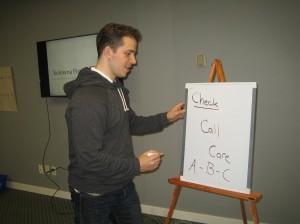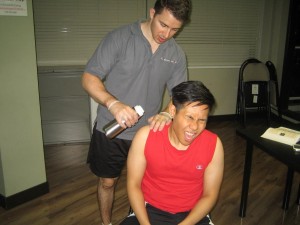Heart attacks and strokes

While heart attacks and strokes are both cardiac conditions, or rather, complications of cardiac disease. Even with statistics ringing warning bells in today’s society, most people still are not aware of what differentiates the two, what causes them, and what can be done to prevent them. As trained health care rescuers and providers, it is part of your job to spread awareness through health education, not merely giving CPR and first aid when a victim is already in front of you.
Stroke
A stroke happens when a the flow of blood through a vessel in the brain becomes blocked. It can be due to a thrombus (build up of plaque), narrowing, or a rupture. Either way, the delivery of blood through that vessel becomes compromised and the tissue that is supplied by the vessel becomes deprived of oxygen. The brain can only last up to ten minutes without oxygen before irreversible damage occurs to the tissue. The medical term for this condition is CVA – cerebrovascular accident.
Heart attacks
Similar to a stroke, a heart attack happens when the blood flow to the cardiac tissue is interrupted, either due to a thrombus, narrowing, or rupture. Without oxygen delivery, the cardiac muscle starts to malfunction, causing an arrhythmia and eventual cardiac arrest. Cardiac arrest happens when the heart stops completely (asystole). The only way to get the heart beating spontaneously again is through the use of CPR and medical management.
CPR training

CPR is made up of three basic techniques that manually compress the heart (chest compression) and oxygenate the blood (ventilation). Ventilation can be done mouth-to-mouth, preferrably through a barrier device, or with a bag valve mask (BVM). The third skill, defibrillation, can only be done if an AED is avaialable. Defibrillation uses electricity to return normal sinus rhythm to the heart. Unlike what you see in TV shows and movies, defibrillation cannot be done if the victim is flatlined (asystole). It can only be used during instances of severe arrhythmia.
We have five training programs in CPR and three re-certification classes. Our programs vary from 4 hours to 16 hours long. Basic courses are typically 4 – 4.5 hours long while advanced courses take as long as two days to complete. All of the programs include basic CPR training.
- Basic CPR and AED (general public)
- Basic CPR and AED C
- Basic Life Support for HCPs*
- Advanced Cardiac Life Support*
- Pediatric Advanced Life Support*
The programs with an asterisk next to the name have re-certification classes available.
Certification
All programs are certificate courses. We award trainees with certificates once they complete the program with a passing grade on the certification exam and complete attendance. The certificates expire after two years but are renewable (before expiration) through re-certification. We do not accept rescuers with expired certificates for renewal.
